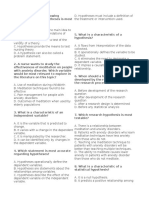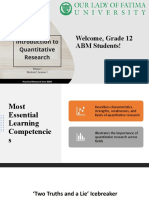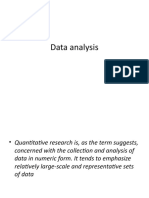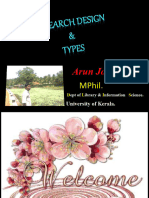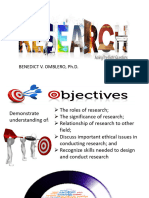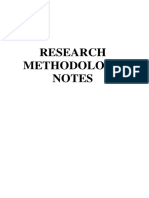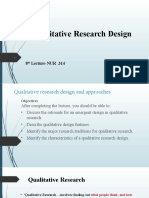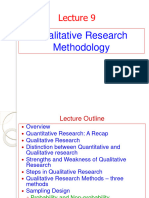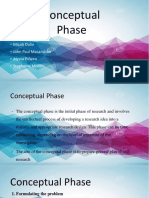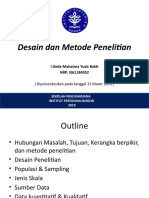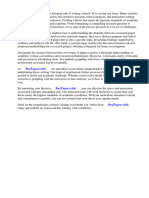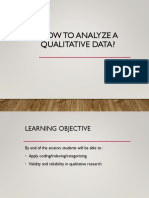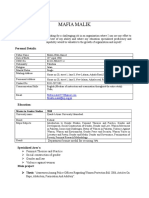0 ratings0% found this document useful (0 votes)
6 viewsField Methods Presentation 2 Overview of Research and Data Collection Methods
Field Methods Presentation 2 Overview of Research and Data Collection Methods
Uploaded by
kenneth pedrosaCopyright:
© All Rights Reserved
Available Formats
Download as PDF, TXT or read online from Scribd
Field Methods Presentation 2 Overview of Research and Data Collection Methods
Field Methods Presentation 2 Overview of Research and Data Collection Methods
Uploaded by
kenneth pedrosa0 ratings0% found this document useful (0 votes)
6 views31 pagesOriginal Title
Field-Methods-Presentation-2-Overview-of-Research-and-Data-Collection-Methods
Copyright
© © All Rights Reserved
Available Formats
PDF, TXT or read online from Scribd
Share this document
Did you find this document useful?
Is this content inappropriate?
Copyright:
© All Rights Reserved
Available Formats
Download as PDF, TXT or read online from Scribd
Download as pdf or txt
0 ratings0% found this document useful (0 votes)
6 views31 pagesField Methods Presentation 2 Overview of Research and Data Collection Methods
Field Methods Presentation 2 Overview of Research and Data Collection Methods
Uploaded by
kenneth pedrosaCopyright:
© All Rights Reserved
Available Formats
Download as PDF, TXT or read online from Scribd
Download as pdf or txt
You are on page 1of 31
Overview of Research and
Data Collection Methods
Field Methods in Psychology
• field methods refer to research approaches and
data collection methods in order to gather data
or information
• The collected “data and information” will be
relevant in fulfilling the goals of the discipline of
psychology
Goals of Psychology
1. To describe behavior
2. To explain behavior (determining the causes of
behavior)
3. To predict behavior
4. To change behavior (for the better)
Lesson Objective
• Distinguish between research methods and data
collection methods
• Distinguish between qualitative and quantitative
research (features strengths, weaknesses, variety,
strategies)
Research Method vs Data Collection Method
• Research Method - overall research design and
strategy
• Method of Data Collection - a technique for
physically obtaining the data to be analyzed in a
research study
Data Collection Methods
(Six most commonly used in psychology)
1. Tests - administering standardized psychological tests to
measure specific variables such as intelligence,
personality traits, or cognitive abilities
2. Questionnaires - collecting data through a series of
written questions that participants respond to.
3. Interviews - collecting data through direct, face-to-face,
telephone, or online communication with participants.
Data Collection Methods
(Six most commonly used in psychology)
4. Focus Groups - involves gathering a small group of
participants to discuss specific topics, guided by a
moderator
5. Observation - involve systematically watching and recording
behavior as it occurs naturally or in a controlled setting
6. Constructed, secondary and existing data - other forms of
data constructed by research participants (primary);
existing data initially utilized for a different purpose
(secondary)
What is research?
• Research is a systematic, objective and
comprehensive investigation of certain
phenomenon which involves accurate gathering
and recording, and critical analysis and
interpretation of all facts about the
phenomenon for theoretical or practical end
(Ardales)
Identification & Definition of a Research Problem
(Literature Review)
Statement of Research Theoretical/Conceptual Operational Definition of
Prob./Obj. Framework Formulation variables
Hypothesis Formulation
H
ARC Choosing Appropriate Research Design
Identification of Target Population and Sampling
RESE
Data Collection
S
CES
Preparation of Reliability Testing Q Administration,
Research and Interview Quality
Instrument Validation Testing & Control
Observation
PRO
THE
Data Processing
(Editing, Coding, Encoding, Creation of Data Files Tabulation)
Data Analysis and Interpretation
(Statistical Analysis, Interpretation, Generalization)
Report Preparation and Information Dissemination
Other Dichotomies of Research
(David, 2005)
• Pure Basic vs. Applied Research
• Exploratory vs. Explanatory
• Quantitative vs. Qualitative Research
• Descriptive vs. Experimental
Activity: Pair Work
Identify the following research titles as either
Quantitative or Qualitative
1. "Examining the Relationship Between Exercise Frequency and
Stress Reduction in Adults"
2. "Investigating the Influence of Parental Income on Children's
Educational Attainment”
3. "Exploring the Factors Influencing Employee Satisfaction and
Turnover in a Large Corporation: A Mixed Methods Inquiry"
4. “Exploring the Lived Experiences of Teachers in High-Stress School
Environments"
5. "A Survey of Customer Satisfaction in Online Shopping"
6. "Understanding the Coping Mechanisms of Cancer Patients During
Treatment
Identify the following research titles as either
Quantitative or Qualitative
7. "An Ethnographic Study of Homeless Individuals in Urban Areas"
8. "The Effect of Sleep Duration on Memory Retention in College
Students"
9. "An Analysis of the Narratives of War Veterans: PTSD and Healing"
10."The Effects of a Parenting Intervention Program on Child Behavior
and Parental Stress: A Mixed Methods Study"
11."The Impact of Social Media Usage on Teenagers' Academic
Performance"
12.Level of Depression, Anxiety and Stress of the Senior High School
Students of a Suburban Private School
Research Designs (Creswell, 2014)
Quantitative Qualitative Mixed Methods
Experimental designs Narrative research Convergent
Nonexperimental Phenomenology Explanatory sequential
designs (Descriptive)
Grounded theory Exploratory sequential
Ethnographies Transformative,
embedded, or
multiphase
Case studies
Four World Views (Creswell, 2014)
Quantitative Research
• Quantitative research involves the collection and
analysis of numerical data to identify patterns,
relationships, and statistical significance.
• Built on the Postpositivist perspective
Quantitative Research Designs
Experimental Non-Experimental
Pre-Experimental Design Surveys
True Experimental Design Relational Studies
Quasi-Experiential Design Comparative Studies
Longitudinal Studies
Cross-sectional Studies
Meta-analysis
(and more...)
Quantitative Research Designs
• Experimental Design: Manipulating variables to assess cause-and-effect
relationships.
• Survey Research: Using structured questionnaires to gather data from a large
sample.
• Correlational Studies: Examining the relationship between variables without
manipulation.
• Comparative Research: Examining the differences among groups or population
• Longitudinal Studies: Observing the same subjects over an extended period.
• Cross-Sectional Studies: Collecting data from individuals at a single point in
time.
• Meta-Analysis: Combining and analyzing data from multiple studies
quantitatively.
Qualitative Research
• Qualitative research focuses on exploring and
understanding complex phenomena through non-
numeric data, such as text, images, or observations.
• Built on the Constructivist Perspective
Qualitative Research Methods
• Narrative research is a qualitative strategy in which the researcher
studies the lives of individuals and asks one or more individuals to
provide stories about their lives. This information is then often retold
or restoried by the researcher into a narrative chronology
• Phenomenological research is a qualitative strategy in which the
researcher identifies the essence of human experiences about a
phenomenon as described by participants in a study
• Grounded theory is a design of inquiry from sociology in which the
researcher derives a general, abstract theory of a process, action, or
interaction grounded in the views of participants.
Qualitative Research Methods
• Ethnography is a design of inquiry coming from anthropology and
sociology in which the researcher studies the shared patterns of
behaviors, language, and actions of an intact cultural group in a
natural setting over a prolonged period of time. Data collection often
involves observations and interviews.
• Case studies are a design of inquiry found in many fields, especially
evaluation, in which the researcher develops an in-depth analysis of a
case, often a program, event, activity, process, or one or more
individuals.
Mixed Methods Designs
• Mixed methods involves combining or integration of qualitative and
quantitative research and data in a research study.
• Qualitative data tends to be open-ended without predetermined
responses while quantitative data usually includes closed-ended
responses such as found on questionnaires or psychological
instruments
• Triangulation —a means for seeking convergence across qualitative
and quantitative methods/data
• The field of mixed methods research is relatively new with major
work in developing it stemming from the middle to late 1980s
Mixed Methods Designs
• Convergent parallel mixed methods is a mixed methods strategy in
which a researcher collects both quantitative and qualitative data,
analyzes them separately, and then compares the results to see if the
findings confirm or disconfirm each other
• Explanatory sequential mixed methods is a mixed methods strategy
that involves a two-phase project in which the researcher collects
quantitative data in the first phase, analyzes the results, and then
uses the results to plan (or build into) the second, qualitative phase.
Mixed Methods Designs
• Exploratory sequential mixed methods is a mixed methods strategy that
involves a two-phase project in which the researcher first collects qualitative
data and then follows up or builds on this database with a second quantitative
data collection and analysis.
• Transformative mixed methods is a form of mixed methods design in which
the researcher identifies one of the qualitative theoretical frameworks (e.g.,
indigenous populations, females, racial and ethnic groups, disabled individuals,
and so forth) and uses the framework through the mixed methods study, such
as to establish the research problem, the questions, the data collection and
analysis, interpretation, and the call for action. It is used in conjunction with
explanatory, exploratory, and embedded designs.
Quanti vs Quali vs Mixed
General Features
Quantitative Emphasizes objective data, statistical analysis,
and generalizability
Qualitative Focuses on subjective experiences, context, and
in-depth understanding.
Mixed Utilizes both quantitative and qualitative data
Methods to triangulate findings and enhance
understanding.
Quanti vs Quali vs Mixed
Data Collection Techniques
Quantitative Surveys, experiments, structured observations
Qualitative Interviews, focus groups, open-ended surveys,
participant observation
Mixed Combines data collection techniques from both
Methods quantitative and qualitative approaches.
Quanti vs Quali vs Mixed
Data Analysis Techniques
Quantitative Descriptive statistics, inferential statistics
Qualitative Coding, thematic analysis, constant
comparative analysis
Mixed Integrates data analysis techniques from both
Methods quantitative and qualitative approaches.
Quanti vs Quali vs Mixed
Research Objectives
Quantitative Testing hypotheses, establishing generalizable
patterns
Qualitative Exploring complex phenomena, generating
theories, understanding context
Mixed Providing a comprehensive view, triangulating
Methods findings, addressing research questions from
multiple angles
Quanti vs Quali vs Mixed
Strengths
Quantitative Objectivity, replicability, statistical rigor
Qualitative In-depth insights, context-rich understanding,
flexibility
Mixed Enhanced depth, breadth, and validity of
Methods findings, addressing diverse research questions.
Quanti vs Quali vs Mixed
Limitations
Quantitative May oversimplify complex phenomena, limited
in capturing context
Qualitative Subjectivity, potential for researcher bias,
limited generalizability
Mixed Requires expertise in both approaches,
Methods resource-intensive.
Ecclesiastes 12:12
12 And further, my son, be
admonished by these. Of making
many books there is no end, and
much study is wearisome to the
flesh.
You might also like
- Research Methods: Simple, Short, And Straightforward Way Of Learning Methods Of ResearchFrom EverandResearch Methods: Simple, Short, And Straightforward Way Of Learning Methods Of ResearchRating: 4 out of 5 stars4/5 (13)
- REVIEW QUESTIONs FOR BRM FINAL EXAMDocument11 pagesREVIEW QUESTIONs FOR BRM FINAL EXAMSang PhanNo ratings yet
- Introduction To Research MethodologyDocument41 pagesIntroduction To Research Methodologyskirubaarun100% (4)
- A Project Report: Master of Business AdministrationDocument41 pagesA Project Report: Master of Business Administrationshiv infotech100% (1)
- NCLEX NursesDocument5 pagesNCLEX NursesAgentpiinkkNo ratings yet
- Introduction To ResearchDocument37 pagesIntroduction To ResearchFaRwa MiRzaNo ratings yet
- Welcome, Grade 12 ABM Students!Document37 pagesWelcome, Grade 12 ABM Students!PSHNo ratings yet
- Quantitative and Qualitative ResearchDocument25 pagesQuantitative and Qualitative ResearchddNo ratings yet
- Quantitative and QualitativeDocument25 pagesQuantitative and QualitativeA Vera DltNo ratings yet
- Chapter Five ResearchDocument50 pagesChapter Five ResearchHagere EthiopiaNo ratings yet
- 05 Research Methodology DesignsDocument15 pages05 Research Methodology DesignsNdaliNo ratings yet
- Lecture 1 QM - IntroductionDocument20 pagesLecture 1 QM - Introductionsyum amareNo ratings yet
- Research Methodology Lecture 4 Research and Experimental Designs1Document100 pagesResearch Methodology Lecture 4 Research and Experimental Designs1macha barakaNo ratings yet
- Qualitative ResearchDocument52 pagesQualitative Researchhjaromptb97% (32)
- The Science and Art of Qualitative Inquiry (Patton, 1988)Document30 pagesThe Science and Art of Qualitative Inquiry (Patton, 1988)shivam_thukralNo ratings yet
- Quantitative Research Methods: Fsehs-ArcDocument27 pagesQuantitative Research Methods: Fsehs-ArcJulius MacaballugNo ratings yet
- Arun Joseph. S: University of KeralaDocument50 pagesArun Joseph. S: University of KeralaSimmi KhuranaNo ratings yet
- BBA-BI-Class 15 BusinessDocument46 pagesBBA-BI-Class 15 Businessghimiremanisha157No ratings yet
- Research DesignDocument53 pagesResearch DesignDaizylie Fuerte100% (1)
- Qualitative Research Designs Case StudyDocument34 pagesQualitative Research Designs Case StudyaizuNo ratings yet
- Research OverviewDocument36 pagesResearch OverviewAriel SajetariosNo ratings yet
- 1 Intro Quantitative ResearchDocument65 pages1 Intro Quantitative ResearchWondwosen TilahunNo ratings yet
- 5 Methodology SectiionDocument31 pages5 Methodology Sectiionmarshallchamunorwa123No ratings yet
- Research DesignDocument4 pagesResearch DesignAshley LigutanNo ratings yet
- L 2 Research DesignDocument26 pagesL 2 Research Designtsheringchoeden19No ratings yet
- Questions MidtermDocument11 pagesQuestions MidtermGiulio LicitraNo ratings yet
- Trinity 2Document26 pagesTrinity 2Yonn Me Me KyawNo ratings yet
- Understanding Academic Research Its Design and Methods ALUNA March 29 2021Document73 pagesUnderstanding Academic Research Its Design and Methods ALUNA March 29 2021Elmalyn BernarteNo ratings yet
- RM Notes 2020Document111 pagesRM Notes 2020ramanvohraNo ratings yet
- Research MethodologyDocument28 pagesResearch Methodologypraveer103100% (7)
- Opt 407Document57 pagesOpt 407teamtruth50No ratings yet
- Research Design: Definition, Elements, Classification, and Common Sources of Errors in Research DesignDocument31 pagesResearch Design: Definition, Elements, Classification, and Common Sources of Errors in Research DesignBandana SigdelNo ratings yet
- Latest Research ProcessDocument29 pagesLatest Research ProcessJade FelecioNo ratings yet
- Ch-1 Nature of ResearchDocument32 pagesCh-1 Nature of ResearchhabtamuNo ratings yet
- Data Analysis in BusinessDocument26 pagesData Analysis in BusinessRaadia HassanNo ratings yet
- Unit Ii - BRMDocument22 pagesUnit Ii - BRMTamil piratesNo ratings yet
- L9 - Qualitative Research DesignDocument12 pagesL9 - Qualitative Research Designsami mohamadNo ratings yet
- ECN4126 Lecture 9Document39 pagesECN4126 Lecture 9213349No ratings yet
- Mixed Methods ResearchDocument48 pagesMixed Methods ResearchAhmad AltarefeNo ratings yet
- Phases of ResearchDocument62 pagesPhases of ResearchAaron ConstantinoNo ratings yet
- Business Research Methods: Dr. Henry MensahDocument31 pagesBusiness Research Methods: Dr. Henry MensahPRAYER BUFFETNo ratings yet
- Suastra 2021 Mixed-MethodsDocument18 pagesSuastra 2021 Mixed-Methodsjeje pamelaNo ratings yet
- Quantitative Research: La Salette of Roxas College, IncDocument56 pagesQuantitative Research: La Salette of Roxas College, Incmac bNo ratings yet
- Quantitative Research: La Salette of Roxas College, IncDocument56 pagesQuantitative Research: La Salette of Roxas College, Incmac bNo ratings yet
- Session 6Document20 pagesSession 6SUBHODEEP MUKHERJEENo ratings yet
- Sociology Lecture 3Document20 pagesSociology Lecture 3rauskalina2No ratings yet
- FND 507 Unit III ReportDocument39 pagesFND 507 Unit III ReportLANI GRACE SUMATRANo ratings yet
- Chapter 6 Research DesignDocument21 pagesChapter 6 Research DesignYOGAMUHILAN A/L SELVAM100% (1)
- 11 - Chapter 4 Basics of Research MethodologyDocument13 pages11 - Chapter 4 Basics of Research Methodologyshivabt07No ratings yet
- Module 1 - 5Document176 pagesModule 1 - 5Sankalp Raj PandeyNo ratings yet
- Tugas Individu I Gede Mahatma Yuda Bakti - Materi Presentasi KMP 611 - Desain Dan Metode PenelitianDocument26 pagesTugas Individu I Gede Mahatma Yuda Bakti - Materi Presentasi KMP 611 - Desain Dan Metode PenelitianYuda ChanNo ratings yet
- Research Method and Design RINGKASDocument24 pagesResearch Method and Design RINGKASYuda ChanNo ratings yet
- The Comparison Qualitative and Quantitative ResearchDocument7 pagesThe Comparison Qualitative and Quantitative ResearchbuntyNo ratings yet
- Research MethodologyDocument31 pagesResearch MethodologySHANNEL ANN VILLUGANo ratings yet
- 800 Research MethodsDocument39 pages800 Research MethodsEAC School of Pharmacy ManilaNo ratings yet
- Chapter 3 - Methods - ReportDocument33 pagesChapter 3 - Methods - ReportAngelica Paler SupasNo ratings yet
- Safarin-Mixed Methods Research-WorkshopDocument36 pagesSafarin-Mixed Methods Research-WorkshopKhairul Nizam HamzahNo ratings yet
- Qualitative Research Process & Postulating Research QuestionsDocument36 pagesQualitative Research Process & Postulating Research Questionsjokydin92No ratings yet
- PR2 Module 1Document17 pagesPR2 Module 1Michael WansNo ratings yet
- Las Pr1 11 Melc 5 Week 1dDocument6 pagesLas Pr1 11 Melc 5 Week 1dRoland Andrey TeñosoNo ratings yet
- Conceptual FrameworkDocument17 pagesConceptual FrameworkMuhamad NordinNo ratings yet
- What Is Document AnalysisDocument6 pagesWhat Is Document AnalysisAnonymous 7I7uUu100% (1)
- Collecting Qualitative DataDocument24 pagesCollecting Qualitative DataEdi Hendri MNo ratings yet
- Conceptual Framework: Professor Roger VaughanDocument28 pagesConceptual Framework: Professor Roger VaughanJopz Campo MirafuentesNo ratings yet
- Difference Between Research Paper and Concept PaperDocument5 pagesDifference Between Research Paper and Concept Paperhozul1vohih3No ratings yet
- Research Proposal:: Integration of Best Practice Guidelines (BPGS) Into An Undergraduate Nursing CurriculumDocument24 pagesResearch Proposal:: Integration of Best Practice Guidelines (BPGS) Into An Undergraduate Nursing CurriculumMuhammad Arsyad SubuNo ratings yet
- How To Analyze A Qualitative Data?Document12 pagesHow To Analyze A Qualitative Data?Kezia N. ApriliaNo ratings yet
- Learning Professionalism PerspectivesDocument8 pagesLearning Professionalism Perspectivesclaimstudent3515No ratings yet
- Vaishnavi Dandekar - Financial Performance Commercial BankDocument67 pagesVaishnavi Dandekar - Financial Performance Commercial BankMitesh Prajapati 7765No ratings yet
- The International Journal of Management Education: Stuart Allen, Peter Williams, Danielle AllenDocument12 pagesThe International Journal of Management Education: Stuart Allen, Peter Williams, Danielle AllenmahedreNo ratings yet
- 1054 4504 3 PBDocument20 pages1054 4504 3 PBAnita SihalohoNo ratings yet
- FinaleDocument12 pagesFinaleChristian Rae LicardoNo ratings yet
- Muafia CVDocument7 pagesMuafia CVSofia Khan100% (1)
- QUANTITATIVE Methods SEXTO MATERIA COMPLETODocument245 pagesQUANTITATIVE Methods SEXTO MATERIA COMPLETOJESLHY DELIANI TORRES BRAVONo ratings yet
- Drivers and Barriers of Reverse Logistics Practices: A Study of Large Grocery Retailers of PakistanDocument11 pagesDrivers and Barriers of Reverse Logistics Practices: A Study of Large Grocery Retailers of PakistanAhsan azizNo ratings yet
- Independent Variables ThesisDocument7 pagesIndependent Variables Thesisfjgmmmew100% (2)
- Ella (Business Research)Document5 pagesElla (Business Research)Jessha DalisayNo ratings yet
- ID Pengalaman Emosi Dan Mekanisme Koping LaDocument14 pagesID Pengalaman Emosi Dan Mekanisme Koping LaAnang DewantaraNo ratings yet
- Hailemeskel Tefera PDFDocument82 pagesHailemeskel Tefera PDFmekides napolionNo ratings yet
- HR's Positioning Analysis To Top-Level Management Planning and Execution: A Qualitative StudyDocument2 pagesHR's Positioning Analysis To Top-Level Management Planning and Execution: A Qualitative StudyIamJmlingconNo ratings yet
- Block 1 FEG 2 Unit 1Document10 pagesBlock 1 FEG 2 Unit 1Manisha BhavsarNo ratings yet
- Qualitative Study - PPT New 11Document68 pagesQualitative Study - PPT New 11Emahren Tampos Juarez100% (1)
- Analysis of School Library Utilization in DevelopiDocument8 pagesAnalysis of School Library Utilization in DevelopiMahdavikiaNo ratings yet
- Final Examination in Practical Research IDocument2 pagesFinal Examination in Practical Research IANNA CLARISSA AVESNo ratings yet
- Uganda Agriculture Sector Semi-Annual Monitoring Report FY 2018-19Document79 pagesUganda Agriculture Sector Semi-Annual Monitoring Report FY 2018-19African Centre for Media ExcellenceNo ratings yet
- Research ProposalDocument15 pagesResearch ProposalZainab AhmedNo ratings yet






